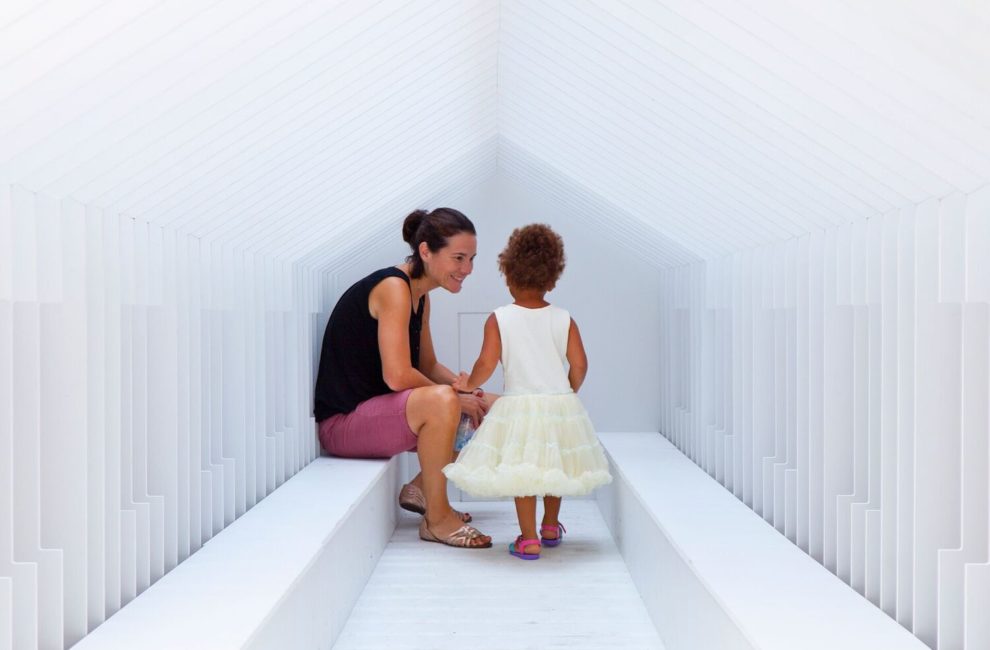
Exhibit Columbus: An Expert's Review
The temporary installations that you’ll find scattered around Columbus, Indiana, through November 26 have intimidating company. They occupy hallowed architectural ground, positioned in dialogue with buildings by Eliel and Eero Saarinen, I.M. Pei, Kevin Roche, Gunnar Birkerts, and many other leading voices of 20th-century architecture and design. But it’s the 21st century that is the concern of the organizers of this first exhibition of Exhibit Columbus, whose 18 outdoor, site-responsive installations are charged with the considerable task of enlivening our engagement with the architectural heritage that has made this small city famous. I was relieved and delighted to find that the installations do indeed hold their own, and do so very successfully.
Five of the projects emerged from the J. Irwin and Xenia S. Miller Prize Competition, through which nationally and internationally recognized design firms were invited to present and submit proposals, with winners selected by jury. Flowing from the minds of such bright talents and backed by healthy budgets, these installations should be impressive and are. IKD’s Conversation Plinth encircles the Henry Moore sculpture that sits outside of the Cleo Rogers Memorial Library, inviting circulation around the sculpture, making the site into a social one, and allowing for elevated views of the plaza, library, and adjacent Eliel Saarinen–designed First Christian Church. These buildings are formidable, and climbing Conversation Plinth felt empowering, a reminder that these spaces were built to be enjoyed by human beings. Oyler Wu Collaborative’s The Exchange sits outside the Eero Saarinen–designed Irwin Conference Center and builds off of the canopies that once served as drive-up tellers in the structure’s first life as a bank. They’ve been transformed into porous but intimate shelters that look both new and like they should have always been there.
Along Washington Street, Columbus’s charming commercial artery, are installations organized by international design galleries. Some of them are unmissable, like Brooklyn-based Snarkitecture’s Playhouse, wedged in an alleyway between Third and Fourth Streets, inviting kids and their keepers alike to test out its forced perspective. Others are much more subtle, like Mexico City–based Productura’s Columbus Circles. A series of low-lying circular elements made of varying materials are attached to building facades and quietly point out the variety of textures and details in the existing architecture that might go overlooked.
Also participating are five Midwestern universities with masters programs in architecture and design, each of whom assembled teams of students and faculty to develop installations on the grounds of Central Middle School. Along this stretch, you have the opportunity to take in a wide range of approaches and materials and techniques—all thoughtful and skillfully rendered.
Along with several other expert contributions by seasoned designers, there’s a colorful and dynamic installation outside the Historic Post Office created by a team of high school students from Columbus—a series of panels strung with plastic lacing whose colors are inspired by the work of Alexander Girard. The beauty of Exhibit Columbus is that it invites and encourages participation at many levels—on the part of the designers who’ve put forward new work, the visitors who seek it out, and the residents who happen to pass it.
Columbus, Indiana, has a long history of combining and intertwining the disciplines of art, architecture, and design so seamlessly that what you get is just life—well-conceived and well-considered life. It’s the reason people travel long distances to see the place, why famed designers want to put their own mark on it, and why a Fortune 500 company is still headquartered there. Exhibit Columbus is a vital reminder of the cultural and economic impact good design can have on a community, and that efforts must be taken to keep the flame alive through the cultivation of new projects and new enthusiasts.
Columbus is always worth a visit. But it is especially worth a visit right now. After November, these installations will disappear. My hope is that the city will miss them and the debate they have sparked, and that in due course, there will be 18 new installations posing fresh and thought-provoking questions about the value of good design.
Sarah Urist Green is creator and curator of The Art Assignment, an educational video series produced in partnership with PBS Digital Studios that introduces you to innovative artists, presents you with assignments, and explores art history through the lens of the present. The series has grown to over 175,000 subscribers, has been watched more than 4 million times, and has generated thousands of artworks in response. Green is the former curator of contemporary art at the Indianapolis Museum of Art, and lives in Indianapolis with her family.






